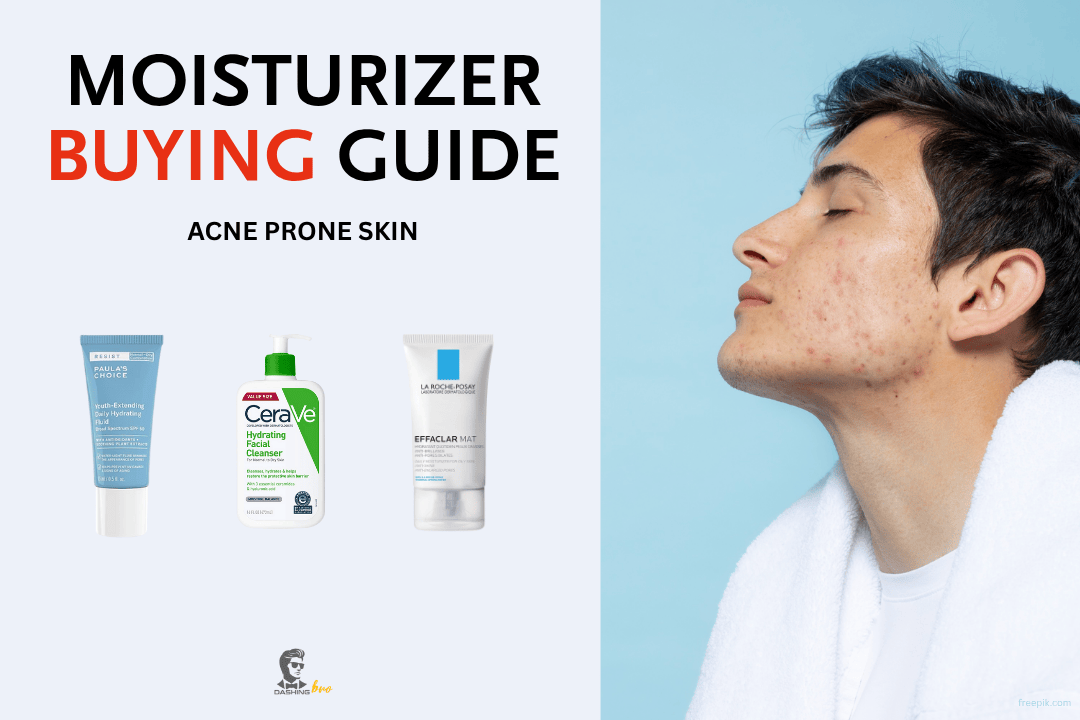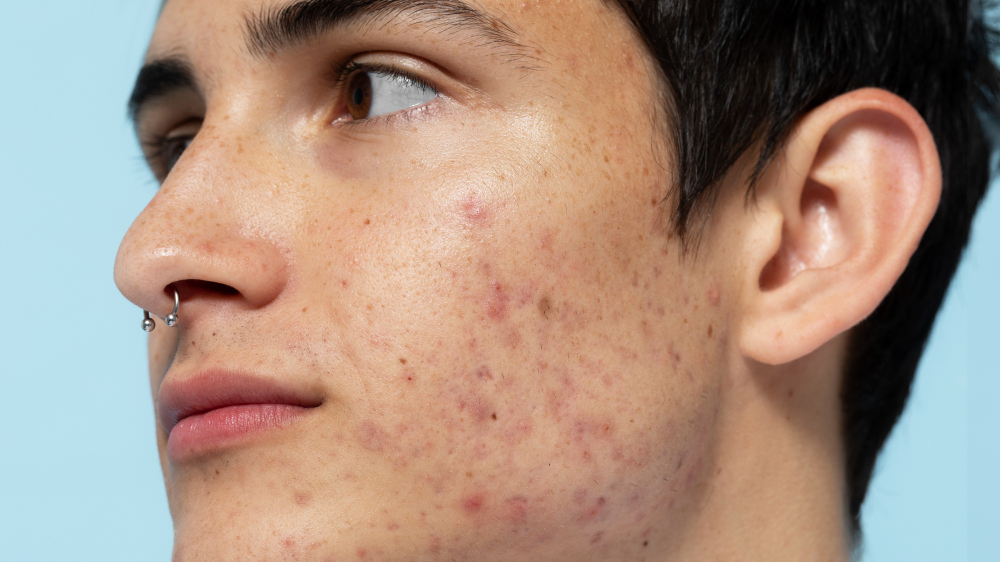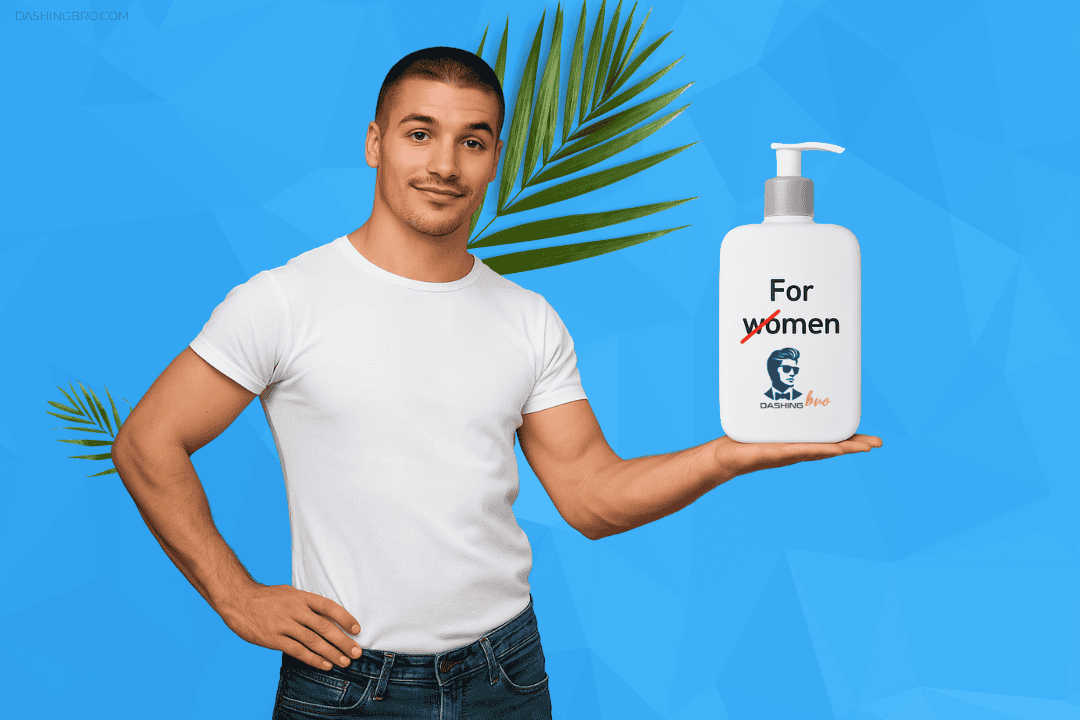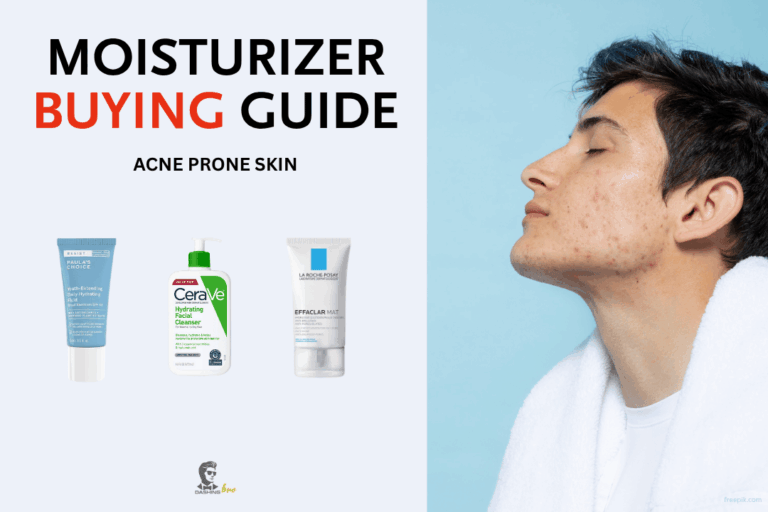
Moisturizer for Acne Prone Skin: The Ultimate Buying Guide for Men
Imagine you are at the skincare store, staring at rows of moisturizers, wondering if slathering cream on your already oily, acne prone face is going to make things worse. Sound familiar? You’re not alone. Many men skip moisturizer entirely, thinking it’ll turn their face into an oil slick or trigger a breakout marathon. Here’s the truth that might surprise you: the right moisturizer can actually be your secret weapon against acne, not the enemy.
If you’ve been battling breakouts and avoiding moisturizer like it’s kryptonite, it’s time to change that mindset. Let’s dive into everything you need to know about finding the perfect moisturizer for acne prone skin and building a routine that actually works.

What is Acne Prone Skin?
Before we talk solutions, let’s get clear on what we’re dealing with. Acne prone skin is exactly what it sounds like—skin that’s more susceptible to developing pimples, blackheads, whiteheads, and cysts than the average person’s. It’s not just about having the occasional zit; it’s about skin that consistently struggles with various forms of acne.
There are two main categories of acne you should know about:
Non-inflammatory acne such as blackheads and whiteheads, also known as open and closed comedones. These are basically clogged pores—blackheads are open to the surface and oxidize, turning dark, while whiteheads are sealed under the skin.
Inflammatory acne is where things get more serious. This includes papules (small, red bumps), pustules (pimples with white or yellow centers), and cysts (deep, painful bumps under the skin). These forms involve bacterial infection and your body’s immune response, which is why they’re often red, swollen, and tender.
Here’s something that might shock you: acne prone skin isn’t just a teenage problem. While hormonal changes during puberty certainly don’t help, plenty of men deal with acne well into their 30s, 40s, and beyond.
What Type of Skin is Usually Acne Prone?
Most people assume that only oily skin gets acne, but that’s not the whole story. While oily skin is indeed the most common culprit—thanks to overactive sebaceous glands producing excess sebum—you can absolutely have acne prone skin regardless of your skin type.
Oily skin is the classic acne-prone type. You’ll notice enlarged pores, frequent breakouts, and that shiny T-zone (forehead, nose, chin) that seems to appear an hour after washing your face. An overproduction of oil creates ideal conditions for acne-causing bacteria to grow.
Combination skin can also be acne prone, typically in the oily T-zone area while the cheeks remain normal or even dry.
Dry skin might seem like it would be exempt from acne, but think again. Dehydrated skin often produces extra oil to make up for the dryness, which can trigger breakouts. Plus, dry skin can lead to more dead skin cell buildup, which clogs pores.
Even “normal” skin can become acne prone due to hormonal changes, stress, diet, or using the wrong products.
The telltale signs of acne prone skin include frequent breakouts, enlarged pores (especially on the nose and cheeks), excess oil production, and skin that seems to react poorly to certain products or environmental factors.
Are All Sensitive Skins Acne Prone?
This is a common misconception that trips up a lot of guys. Sensitive skin and acne prone skin are two completely different things, though they can definitely overlap and make your life more complicated.
Sensitive skin tends to respond quickly to skincare products, changes in weather, or other environmental triggers. You might experience redness, burning, stinging, or irritation from products that work fine for others. Your skin is essentially more reactive and easily irritated.
Acne prone skin, on the other hand, is defined by its tendency to develop breakouts. It’s about clogged pores, bacterial overgrowth, and inflammation—not necessarily sensitivity to products.
However, many men do have both sensitive AND acne prone skin, which creates a tricky balancing act. It’s important to use products that are powerful enough to treat acne without aggravating your sensitive skin. This is where the right moisturizer becomes crucial—it can help strengthen your skin barrier and reduce sensitivity while supporting your acne treatment routine.
At What Age Does Acne Prone Skin Develop in Men?
Acne often begins in puberty (around ages 12–16), but it doesn’t always stop there. Hormonal changes during teenage years cause sebaceous glands to enlarge and produce more oil, which is why acne is so common during this time.
But here’s what many people don’t realize: adult acne in men is incredibly common. Studies show that up to 40% of adult men experience acne, with many continuing to deal with breakouts well into their 30s, 40s, and even 50s. Some men even develop acne for the first time as adults, which can be particularly frustrating.
Adult male acne often presents differently than teenage acne. It tends to be more inflammatory (think deep, painful cysts rather than surface-level whiteheads) and commonly appears along the jawline, neck, and back—areas where men shave or sweat more.
The reasons for adult acne in men include ongoing hormonal fluctuations, stress, diet, genetics, and even certain medications. This is why it’s so important to have a solid skincare routine that includes the right moisturizer for acne prone skin, regardless of your age.
External and Internal Factors Causing Acne Prone Skin
Understanding what triggers your acne can help you make better choices about products and lifestyle habits. A combination of internal and external factors contributes to the development of acne-prone skin.
Internal Factors:
Hormonal fluctuations are the biggest internal trigger. Testosterone levels naturally fluctuate throughout your life, and higher levels can stimulate oil production. This is why some men notice breakouts during times of stress or life changes.
Genetics play a huge role—if your parents dealt with acne, you’re more likely to as well. While you can’t alter your genetics, you can manage their effects with the right approach.
Stress doesn’t directly cause acne, but it triggers cortisol production, which can worsen existing acne and slow healing.
Diet is controversial, but research suggests that high-glycemic foods (think white bread, sugary snacks) and dairy products may worsen acne in some people. It’s not universal, but worth paying attention to.
External Factors:
Environmental pollution can clog pores and increase inflammation. If you live in a city or work in a dusty environment, this could be contributing to your breakouts.
Poor skincare habits like over-washing, using harsh products, or not removing sunscreen properly can all trigger acne.
Hot, humid weather increases sweating and oil production. Many men notice their acne gets worse in summer.
Lack of sleep affects your immune system and stress hormones, potentially worsening acne.
Certain products including hair gels, aftershaves with alcohol, or heavy moisturizers can clog pores or irritate skin.
Let’s bust a myth while we’re here: greasy food doesn’t directly cause acne by making your skin oilier. However, a diet high in processed foods and sugar can contribute to inflammation and hormonal imbalances that worsen acne.
Is Acne Prone Skin Curable?
Here’s the honest answer: acne prone skin can be managed and significantly improved, but for most people, it’s not “curable” in the traditional sense. Think of it more like managing a chronic condition rather than curing a temporary problem.
The good news is that with consistent skincare, healthy lifestyle choices, and, when necessary, medical treatment, most men can enjoy clearer, healthier skin. The key is consistency and patience. Acne treatments typically take 6-12 weeks to show significant results, so don’t give up if you don’t see immediate changes.
Some people do “outgrow” their acne prone skin as hormone levels stabilize with age, but others continue to deal with occasional breakouts throughout their lives. The goal isn’t perfection; it’s finding a routine that keeps your skin as clear and healthy as possible.
Common Medications for Acne Prone Skin
When over-the-counter products aren’t cutting it, medications can be game-changers. Here’s what’s available:
Over-the-Counter Options:
Benzoyl peroxide (2.5-10%) kills acne-causing bacteria and helps prevent clogged pores. Begin with a milder strength to minimize the risk of irritation.
Salicylic acid (0.5-2%) is a beta-hydroxy acid that exfoliates inside pores, helping to prevent blackheads and whiteheads.
Adapalene (0.1%) is a retinoid that’s now available without prescription. It helps prevent clogged pores and reduces inflammation.
Prescription Options:
Topical retinoids like tretinoin and tazarotene are more potent than over-the-counter versions and highly effective for preventing clogged pores.
Topical antibiotics like clindamycin help reduce bacteria and inflammation.
Oral antibiotics such as doxycycline or minocycline may be prescribed for inflammatory acne.
Isotretinoin, previously known as Accutane, is typically used for stubborn, severe acne and must be taken under strict medical supervision.
Important note: Always consult with a dermatologist before starting new medications, especially prescription treatments. They can assess your specific situation and recommend the best approach.
Ingredients That Help Acne Prone Skin in Men
When shopping for moisturizers and other products for acne prone skin, look for these powerhouse ingredients:
Salicylic acid is your pore-clearing champion. This beta-hydroxy acid penetrates oil and exfoliates inside pores, preventing blackheads and whiteheads. This ingredient works especially well for men who struggle with excess oil.
Benzoyl peroxide is the bacteria-fighting heavyweight. It kills Propionibacterium acnes (the bacteria that contributes to acne) and helps prevent new breakouts from forming.
Niacinamide (Vitamin B3) is a multitasker that reduces inflammation, regulates oil production, and minimizes the appearance of pores. It’s mild enough for sensitive skin and combines easily with most other skincare ingredients.
Retinoids (retinol, adapalene, tretinoin) promote cell turnover, preventing dead skin cells from clogging pores. They also help fade acne scars over time.
Hyaluronic acid provides lightweight hydration without clogging pores. This is crucial for acne prone skin that still needs moisture.
Ingredients to Avoid:
Heavy oils like coconut oil or cocoa butter can clog pores in acne-prone individuals.
Comedogenic ingredients such as isopropyl myristate, acetylated lanolin, or certain silicones.
Products containing alcohol can strip the skin too much, causing it to produce even more oil in response.
Scented products and essential oils may trigger irritation in sensitive or breakout-prone skin.
Best 5 Products for Acne Prone Skin (Men)
Before we start, there’s one thing which is important worth mentioning specially when you are searching the market for best skincare products. Skincare is NOT gender specific even though some products are marketed “labeled for women“. In fact, in many cases products that are labeled for women might work best for your skin. Therefore, do not limit your research to men only products.
Based on dermatologist recommendations and user reviews, here are five top-rated moisturizers specifically effective for men with acne prone skin:
(Affiliate Disclosure: We may earn a small commission without you needing to pay extra.)
1. CeraVe PM Facial Moisturizing Lotion
Key ingredients: Niacinamide, hyaluronic acid, ceramides Why it works: This lightweight, non-comedogenic formula provides 24-hour hydration while niacinamide helps control oil and reduce inflammation. Ceramides support the repair of the skin’s protective barrier, which can be weakened in acne-prone skin. User experience: “At last, a moisturizer that keeps my skin clear without causing breakouts. Absorbs quickly and keeps my skin hydrated without the grease.” – verified Amazon reviewer
2. Neutrogena Hydro Boost Water Gel
Key ingredients: Hyaluronic acid Why it works: This ultra-light gel formula provides essential hydration without any oily residue. It’s formulated especially for those with oily or acne-prone skin. User experience: Users consistently praise its lightweight feel and non-greasy finish, making it ideal for men who want hydration without heaviness.
3. La Roche-Posay Effaclar Mat
Key ingredients: Sebulyse, thermal spring water, silica Why it works: This mattifying moisturizer controls excess oil while providing hydration. The Sebulyse technology helps regulate sebum production throughout the day.
User experience: Highly rated by men with oily skin who need long-lasting oil control without sacrificing moisture.
4. Kiehl’s Facial Fuel Energizing Moisture Treatment
Key ingredients: Caffeine, chestnut extract, vitamins C and E Why it works: Designed specifically for men’s skin, this energizing moisturizer provides hydration while caffeine helps reduce puffiness and improve skin texture. User experience: Popular among men for its masculine scent and energizing feel, plus it works well under sunscreen.
5. The Ordinary Natural Moisturizing Factors + HA
Key ingredients: Hyaluronic acid, amino acids, fatty acids Why it works: This budget-friendly option mimics the skin’s natural moisturizing factors without any potentially pore-clogging ingredients. It’s simple, effective, and affordable. User experience: Praised for being no-nonsense and effective, especially by men who prefer simple, ingredient-focused skincare.
Top 10 Tips to Treat Acne Prone Skin (Men)
Here are the most effective strategies for managing acne prone skin:
1. Use a Gentle, Non-Comedogenic Cleanser
Wash your face twice daily with a mild cleanser that won’t strip your skin’s natural oils. Choose products labeled “non-comedogenic”—they’re made to avoid blocking pores.
2. Moisturize Daily with an Oil-Free Formula
Don’t skip moisturizing just because your skin is oily. Opt for lightweight or gel-based formulas made for acne-prone skin. Well-hydrated skin actually produces less oil.
3. Avoid Harsh Scrubs and Over-Washing
Scrubbing harder won’t clear acne faster—it’ll just irritate your skin and potentially make breakouts worse. Stick to gentle cleansing twice daily.
4. Always Use Sunscreen
Look for “non-comedogenic” or “oil-free” sunscreens. Sun damage can worsen acne scars and some acne medications make your skin more sensitive to UV rays.
5. Keep Your Hands Off Your Face
Picking and squeezing pimples can lead to scarring and spread bacteria to other areas of your face. If you need to remove, it’s best to let a skincare professional handle it.
6. Change Your Pillowcase Regularly
Dirty pillowcases harbor bacteria and oil. Change them at least twice a week, or daily if you’re dealing with active breakouts.
7. Watch Your Diet
While diet isn’t the main cause of acne, some men notice improvements when they limit dairy and high-glycemic foods. Track your diet with a food journal to spot any patterns that may be triggering breakouts.
8. Manage Stress Effectively
Chronic stress can worsen acne through hormonal pathways. Find healthy outlets like exercise, meditation, or hobbies to manage stress levels.
9. Get Adequate Sleep
Aim for 7-9 hours of quality sleep. Your skin repairs itself overnight, and poor sleep can worsen inflammation and slow healing.
10. See a Dermatologist for Persistent Acne
If over-the-counter products aren’t working after 6-8 weeks, it’s time to see a professional. Dermatologists can prescribe stronger treatments and help prevent scarring.
Conclusion
Managing acne prone skin doesn’t have to be a daily battle. The key is understanding that your skin needs hydration, not harsh treatment, and that the right moisturizer can be your ally in achieving clearer, healthier skin.
Remember, everyone’s skin is different, and what works for your buddy might not work for you. Start with gentle, proven ingredients like niacinamide and hyaluronic acid, be consistent with your routine, and give products time to work before switching to something else.
Your acne prone skin isn’t a flaw to hide—it’s a skin type that needs the right care and attention. With the right moisturizer for acne prone skin and a solid routine, you can achieve the clear, confident complexion you’re looking for.
Ready to transform your skincare game? Start with one of the recommended moisturizers above and commit to a consistent routine for at least 6-8 weeks. Your future self (and your skin) will thank you for taking action today.
Have questions about your specific skin concerns or want to share your own success stories? The journey to clearer skin is always easier when you’re not going it alone.


